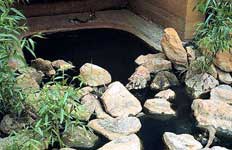
Water
Pollution: Sewage
 Sewage
is generally a point-source pollutant. Sewage is the waste water from
residential and commercial buildings. Degradation
of stream water quality by untreated or insufficiently treated sewage
is a widespread problem in many rural areas. Home owners in these communities
are often responsible for providing their own septic systems. Many times
these systems are improperly installed. They leak their contents into
the groundwater. Some rural home owners cannot afford to install septic
systems at all, so they pipe their sewage directly into local streams.
Photo
Combined sewage outflow along Wheeling Creek. Photo courtesy of Dr. Ben
Stout.
Sewage
is generally a point-source pollutant. Sewage is the waste water from
residential and commercial buildings. Degradation
of stream water quality by untreated or insufficiently treated sewage
is a widespread problem in many rural areas. Home owners in these communities
are often responsible for providing their own septic systems. Many times
these systems are improperly installed. They leak their contents into
the groundwater. Some rural home owners cannot afford to install septic
systems at all, so they pipe their sewage directly into local streams.
Photo
Combined sewage outflow along Wheeling Creek. Photo courtesy of Dr. Ben
Stout.
Urban communities also face the problem of sewage in their stream water. These communities typically have water treatment plants where sewage is chemically treated then piped to nearby rivers and streams. The untreated sewage, along with stormwater runoff, is often carried to the sewage treatment plant in combined sewage outflows (CSOs).
During heavy downpours, stormwater runoff overwhelms the treatment plant. Consequently, a system of gates opens and releases the excess runoff -- along with the untreated sewage -- into nearby waterways.
Sewage carries excessive nutrients such as nitrogen and phosphorus to stream water. The excessive nutrients can lead to decreased levels of dissolved oxygen as a result of the process of eutrophication. Sewage also contributes to increased total solids , including fecal coliform, as well as increased water temperature.
Overview
..|.. Acid
Mine Drainage ..|..
Agriculture
..|.. Sewage
..|.. Dredging Home
..|..
Teacher Pages
..|..
Modules
& Activities
Glossary .|.
Related Links
.|..
References
..|..
PBL Model
.|
HTML code by Chris Kreger
Maintained by ETE Team
Last updated November 10, 2004
Some images © 2004 www.clipart.com
Privacy Statement and Copyright © 1997-2004 by Wheeling Jesuit University/NASA-supported Classroom of the Future. All rights reserved.
Center for Educational Technologies, Circuit Board/Apple graphic logo, and COTF Classroom of the Future logo are registered trademarks of Wheeling Jesuit University.